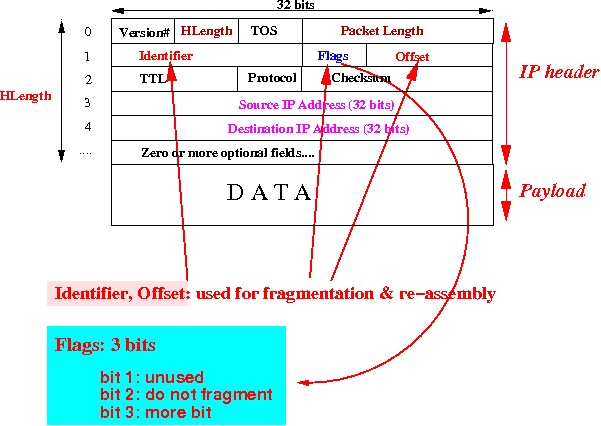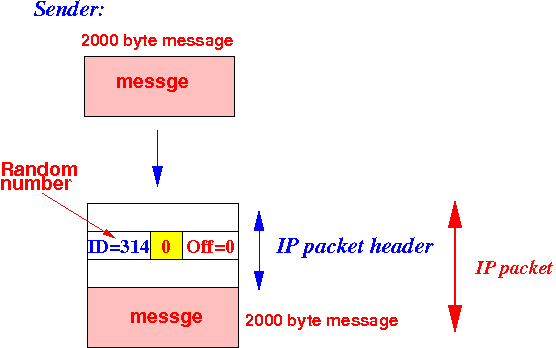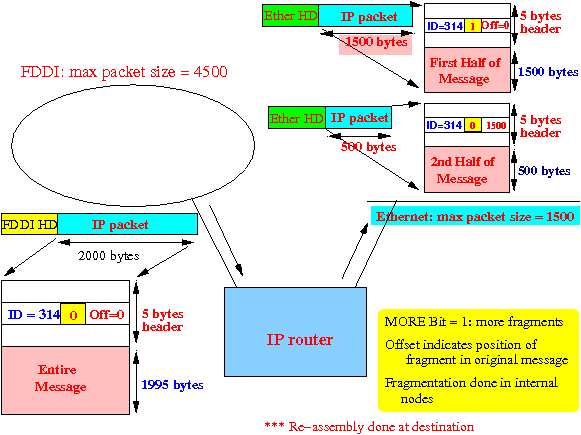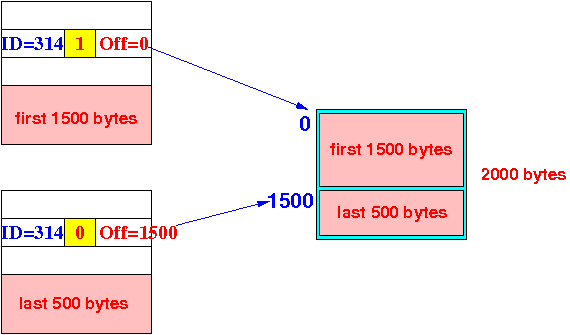- Information field
in the IPv4 packet header
used to implement the
fragmentation/re-assembling procedure:
- Identifier:
- The identifier field
contains a random number
- The random number is generate by the sender of the IP packet
- The identifier field is
used to identify the fragments
from the
same IP packet:
- All fragments from the same (original) IP packet will have the same value for the identifier field
- The identifier field
contains a random number
- The MORE bit:
- 1 = this fragment is not the last fragement
- 0 = this fragment is the last fragment of the IP packet.
- Offset:
- The offset field contains the
offset (position) of the
IP packet fragment
within the
original (whole) message.
- The different fragments can be re-assembled using the value of the offset values in this information field
- The offset field contains the
offset (position) of the
IP packet fragment
within the
original (whole) message.

- Identifier:
- Example: Fragmentation
- A sender transmits a
message consisting of
2000 bytes:

The sender has generate the random number 314 as identifier
- The original IP packet will
contain:
- identifier = 314
- More bit = 0 (because the current fragment is the last fragement)
- Offset = 0 (because the current fragment is first piece)
- The IP packet can be
fragmented as follows
into 2 (two) IP packets:

Notice that:
- The identifier,
More bit and
offset will
allow the
receiver to:
- Re-assemble the different fragments back into the original message !!!
- The identifier,
More bit and
offset will
allow the
receiver to:
- A sender transmits a
message consisting of
2000 bytes:
- How the
IP fragments will
be transmitted in
Ethernet frames:

- Example:
- IP fragments are
concatenated in
an assembly buffer using
the offset in the
IP header:

- IP fragments are
concatenated in
an assembly buffer using
the offset in the
IP header:
- The IPv6 header:

Notice that:
- The identifier and other fields used for fragmentation/re-assembly are missing !!!
- Fact:
- The IPv6 protocol header does not contains fragmentation/re-assembly information
- How IPv6 supports
fragmentation/re-assembly:
- Fragmentation/re-assembly is an extension (option) in the IPv6 protocol
- Extensions in
IPv6:
- Extensions are specified
using
a extension header
- The extension headers
are located immediately
after
the IPv6 header
Recall:
- The Next Header field in the IPv6 header will point to the first extension header
- Extensions are specified
using
a extension header